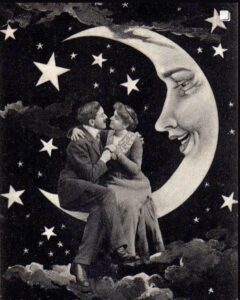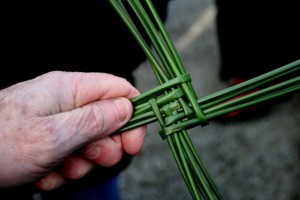First of February and whoa, there’s a lot going on this time around, isn’t there? These first few days of February are all about transitions: from one seasonal perspective to the next, and this year, in China, from one year to the next. Let’s begin there, where it is already tomorrow and where the new moon has brought the Year of the Water Tiger: it is the start of Chinese Lunar New Year. The preparations began last week with a thorough cleaning of the house. This, to wash away all bad things from the previous year. Now that the celebration’s begun, there is feasting with family and with friends and there are dumplings and all sorts of new year foods, many rich in symbolism: round like the year and the sun that shines above.
Here is how Tiger came to be third of the twelve animals of the Chinese zodiac: When the Jade Emperor announced that the order of the zodiac animals would be determined by a race and by when they each arrived at his palace, it was pretty much a given that Ox would arrive first thanks to his great strength and the stride of his mighty steps. However, Rat, who was one of the smaller animals, asked Ox for a ride, to which Ox obliged, for Ox was strong and also kind. Rat enjoyed the ride, but Rat was a bit of a trickster, and just as Ox was about to enter the palace, Rat jumped off Ox and entered the palace first. This is why Rat is the first of the animals of the Chinese zodiac, and why Ox is second. Tiger, a natural runner, ran a good race, but there was a river to cross as part of the course, and Tiger lost some momentum there and drifted off course a bit. Tiger was the third to arrive at the Jade Emperor’s palace, ahead of the rabbit, the dragon, the snake, the horse, the goat, the monkey, the rooster, the dog, and the pig. But this year is Tiger’s year, and the element associated with Tiger this year is water. The new year celebration kicks off now and runs for sixteen days, through Lantern Festival, when the full moon returns and the celebration concludes.
While Chinese New Year roves the calendar due to its lunar nature, there are some things that the First of February always brings: St. Brigid’s Day and Candlemas Eve, and along with these celebrations of the Church, the older earthbound celebration of Imbolc (upon which the church celebrations are built). Candlemas naturally follows on the Second, and along with it, Groundhog Day. St. Blaise’s Day follows on the Third. Here, then, is your Convivio Book of Days guide to the ceremonies of these days, a guide to the week ahead:
ST. BRIGID’S DAY, IMBOLC
There are four cross quarter days in the year; each is marked by accompanying holydays/holidays. The one we most recently celebrated was at the end of October and start of November: Halloween, All Saints Day, and All Souls Day––the Days of the Dead. We were approaching winter, and like burrowing animals and trees focusing growth on roots, life was descending below the earth. But today, as February begins, the wheel of the year shifts and we reach the next period of cross quarter days, marking the first stirrings of earth’s awakening on the approach to spring. Winter still has a firm grip, to be sure (two feet of snow in Boston this past weekend, and even here in Lake Worth, where summer spends winter, we had lows in the 30s), but one thing to keep in mind with these traditional ways of reckoning time is they are always a small step ahead of the game. In this reckoning, the equinox in March will mark the height of spring… and so spring’s beginnings start here, as January melts into February.
St. Brigid, sacred to Ireland and second in stature there only to St. Patrick, is honored on the First of February. In the older earthbound religions, the day honors the Celtic goddess Brigid and brings the season of Imbolc. As the goddess goes, the old crone of winter is reborn now as the young maiden, for this is a time of preparation for renewal. The seeds that were planted beneath the earth last fall are preparing to bring forth lush green life, once spring truly arrives. For St. Brigid’s Day, it is traditional to fashion a St. Brigid’s Cross out of rushes or reeds (pictured below), as well as to leave an oat cake and butter on a windowsill in your home. This, to encourage Brigid to visit your home and bless all who live there. Brigid is typically depicted holding her cross of rushes in one hand and an illuminated lamp in the other––bridging, again, the themes of light in the darkness of midwinter with the green of approaching spring.
CANDLEMAS, GROUNDHOG DAY
Once the sun sets on St. Brigid’s Day, we enter into Candlemas Eve this first night of February. This is the night that all remaining Yuletide greenery is removed from the home, but it is traditional to keep nativity scenes up through Candlemas, the next day. I know many of you are reading and wondering how we could possibly still have Christmas to take down, but keep in mind that in this house our decorating did not begin in earnest until the days just before Christmas. We gave the Advent season its proper space and time and have done the same with Christmas. And now, forty days have passed since the Midwinter solstice and we are now halfway from there to the vernal equinox in March. While the major festivities and revelry of Christmas in years past traditionally ended with Epiphany (the Twelfth Day of Christmas), the spirit of the season remained and lingered and kept folks company for all these forty wintry days. But it was considered bad luck even then to keep these Yuletide things about the house any longer than Candlemas Eve. Our old reliable 17th century Book of Days poet Robert Herrick describes the significance of this night in his poem “Ceremony Upon Candlemas Eve”:
Down with the rosemary, and so
Down with the bays and misletoe;
Down with the holly, ivy, all,
Wherewith ye dress’d the Christmas Hall:
That so the superstitious find
No one least branch there left behind:
For look, how many leaves there be
Neglected, there (maids, trust to me)
So many goblins you shall see.
And so our Christmas tree will be brought outside this first night of February, as we return to nature what is hers. We’ll keep the tree in a quiet corner of the yard––easy to do here, since our yard is a bit of forest––and all the year long it will remind of us of Christmas whenever we by chance brush against it and get a whiff of its balsam fragrance. And when the nights grow long again next December, it will fuel our solstice fire, connecting one Christmas to the next. And tonight, a celebratory bottle of St. Bernardus Christmas Ale will help make the occasion less sad, as we see our old friend Christmas off for another year.
But alas, Old Father Christmas must be on his way to clear the path for what is next, and with Christmas removed (and ill luck kept at bay), we’ll shift perspective on the Second of February to Candlemas, a beautiful celebration in its own rite, and the second step on the bridge to spring that Brigid lays before us. Candlemas is the day that candles are blessed in the church, but it is also known as Purification Day, which harkens back to an old Hebrew tradition: forty days after the birth of a son, women would go to the temple to be purified. Again, renewal. And so Mary did this, for it was her tradition, and when she did, it was there at the temple that she and her infant child ran into the elders Simeon and Anna, who recognized the child as “the Light of the World.” This is the basis for the blessing of candles on this day, and the day’s lovely name, which is even more beautiful in other languages: la Candelaria in Spanish, la Chandeleur in French. In France, the traditional evening meal for la Chandeleur is crêpes. In Mexico, la Candelaria is a night for tamales and hot chocolate. In Puno, Peru, the Candelaria celebration is typically so big, it rivals that of Carnival in Rio de Janeiro. But for most, Candlemas is a quiet celebration, at home. The darkness of the darkest nights of Midwinter closely lingers, but the light of Candlemas is a powerful metaphor. One of my favorite Candlemas traditions is to go through the house at sunset, lighting every lamp, even for just a few minutes. And my favorite song for the day is an old carol called “Jesus, the Light of the World.” Is it a carol for Candlemas? Who knows. Certainly the words echo those of Simeon the Elder in the temple, so for me, I say it is.
Most famously, perhaps, Candlemas is known as an old weather marker. As the old saying goes: If the sun shines bright on Candlemas day / The half of the winter’s not yet away. The tradition of Candlemas as weather marker is particularly strong in Germany. And while Candlemas itself is not celebrated with any great gusto here in the States, this remnant of tradition remains in our yearly observation on the Second of February of Groundhog Day, in which the observations of an old groundhog in Pennsylvania (where many Germans settled) determine how much longer winter will last. Did old Candlemas weather lore influence the traditions that revolve around Punxsutawney Phil? Of this we can be pretty certain.
ST. BLAISE’S DAY
Finally, to close out this luminous chapter, the Third of February will bring St. Blaise’s Day, and the traditions for St. Blaise’s Day, it would seem, come directly out of having all those candles about on Candlemas. For ailments of the throat, we pray to St. Blaise… and on his feast day, it is not uncommon to go to church to have the priest bless your throat by holding two candles, crossed into an X shape, with your throat in the crook of the candles, as he says a blessing over your head. It’s one of those mystical ceremonies that seems almost over the top even to us Catholics.
St. Blaise is fondly remembered in my family, for St. Blaise was the name of the church my grandparents attended, up the hill from their home in Brooklyn. In England and Scotland, it was once customary to light bonfires on the eve of St. Blaise, which would be the night of Candlemas, and perhaps there is some connection to be made between Blaise and blaze. It is a day also important to wool carders (a matter having to do with St. Blaise’s martyrdom), as well as to spinners and dyers.
What is most apparent across these few days and nights upon the bridge that delivers us from winter to spring is the significance of light, be it in candle or bonfire or in song or even in those crêpes, whose golden round shape call to mind the image of the shining sun. Hide not your light, then. Be a light to the world. And rest assured that spring is on its way.
YOUR FEBRUARY BOOK of DAYS CALENDAR
This month’s Convivio Book of Days calendar awaits! It’s our monthly gift to you, a PDF document printable on standard US Letter size paper. You’ll find the calendar a fine companion to this blog; click here to get it. Enjoy!
SHOP OUR VALENTINE SALE!
Spend $75 across our catalog and take $10 off, plus get free domestic shipping, when you enter discount code LOVEHANDMADE at checkout. That’s a total savings of nearly 20 bucks. Click here to start shopping. We’ve got some wonderful new handmade artisan goods from Mexico (hand embroidered hearts, punched tin, Frida mirrors and crosses), new flour sack tea towels (some hand-embroidered by my mom and screen printed by the folks at Kei & Molly Textiles in New Mexico) and some brand new additions from the Sabbathday Lake Shakers, too (the most intoxicating potpourri, a recipe from 1858), to surprise your sweetheart and delight your darlin’. I think you’ll love what we’ve got in store at conviviobookworks.com… and your purchases translate into real support for real families, small companies, and artisans we know by name.
JOIN US FRIDAY via ZOOM
We gather each and every Friday afternoon (unless unforeseen circumstances pop up) for a virtual social on Zoom called Real Mail Fridays. It’s part of my work at the Jaffe Center for Book Arts, and it’s become the most heartwarming thing. You’re welcome to join us, too. 2 to 5 PM Eastern; come and go as you please. This week we’re celebrating the Year of the Tiger with music to calm the emotions (An Dun) and to invigorate the spirit (Sheng Hua). We are a small and loyal group and new folks join in all the time from all over the US, plus Canada, Finland, and most recently, Macedonia. It’s supremely heartwarming. Join us through the link you’ll find here.




The Blessing of the Throats as a Holy Day of Obligation was the last straw for me as a coming of age Catholic girl in the early 60’s. Your reference to it here made me smile, and remember my father who shared that he thought it was over the top too. But he also shared that my Hungarian convent educated grandmother would insist, so off we went. For her, over my full throated objection.
Glad I could make you smile, Laurel. My husband Seth is not a Catholic, but Episcopalian (which seems more Catholic to me now, since they still use the same responses we used to use at Mass); the first time he came with me on St. Blaise Day to have his throat blessed, he wound up the next day with a sore throat. He’s avoided it ever since.